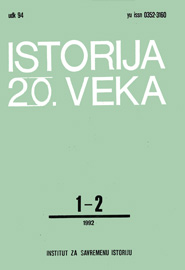GRANICA KRALJEVINE SHS S ALBANIJOM
THE BORDER BETWEEN YUGOSLAVIA AND ALBANIA
Author(s): Živko AvramovskiSubject(s): Diplomatic history, Political history, Recent History (1900 till today), Pre-WW I & WW I (1900 -1919), Interwar Period (1920 - 1939), Between Berlin Congress and WW I, Geopolitics
Published by: Institut za savremenu istoriju, Beograd
Keywords: Yugoslavia; Albania; border; Berlin congress; Turkey; foreign policy; Balkan war;
Summary/Abstract: The question of Albanian borders was opened towards the end of the 19th c., especially during the Berlin Congress when borders between Serbia, Montenegro and Turkey were being determined. At the time Albanians demanded autonomy for Albania within Turkey and expressed aspirations of a general sort regarding the territories of the vilayets Shkodra, Kosovo, Bitola and loannina. These aspirations were put forth with more precision during the uprising in 1912, when the following territory was demanded: the whole Shkodra vilayet, the whole loannina vilayet, the Prizren, Priština, Peć and Novi Pazar sanjaks and Tetovo kaza from the Kosovo vilayet, and the Debar, Elbasan and Когсё sanjaks from the Bitola vilayet. Burdened by problems in foreign politics, the Turkish government accepted these demands on 4 September but was prevented from fulfilling them by the outbreak of the Balkan War. After the quick victories of the Balkan allies, the Albanian leaders decided to break all ties with Turkey, having judged that it would definitely have to withdraw from the Balkans. On 1 November 1912 they declared an independent Albanian state and set up a temporary government in Valona. Austria-Hungary and Italy fully supported this move, seeing the creation of an Albanian state as the best barrier to the possibility of Serbia’s exit on the Adriatic Sea. After signing a truce, the representatives of the warring parties met in London on 16 December 1912 to begin peace negotiations. At the same time the ambassadors of the six great powers also et, supposedly to mediate between the warring parties but in actuality they dictated the terms of the peace settlement or rather, he division of Turkish territories in the Balkans. The first decision made at the conference of the ambassadors was that an independent, neutral Albanian state should be founded. The peace treaty between the Balkan allies and Turkey was signed on 30 May 1913. This treaty did not resolve the question of determining borders between the newly-founded Albanian state and its neighbors but left decisions regarding this up to the conference of the ambassadors of the great powers. Here the extreme demands of the interested parties and the different interests of the great powers became evident. However, none of the great powers challenged the question of the annexation of Kosovo and Metohia to Serbia and Montenegro. The negotiations centered on disputes over the cities Shkodra, Peć, Djakovica, Prizren, Debar and Ohrid, and were ended with a compromise according to which Shkodra was given to Albania, Peć and Djakovica to Montenegro, and Prizren, Debarand Ohrid to Serbia. An international committee was formed to mark the border lines but at the outbreak of the First World War it had still not accomplished its task. During the First World War both warring parties used the Albanian territory as bait for winning over allies to their side. In this sense Austria-Hungary planned to annex Kosovo and Metohia to Albania and then to annex the latter to itself, or put it under Austro-Hungarian protectorate. At the same time Austria-Hungary had promised south Albania to Greece, in return for Greece's continued neutrality and had hinted to Bulgaria that it might get parts of central Albania. On the other side the powers of the Entente had promised, by the London Treaty of 1915, Valona with its hinterland to Italy, with the possibility of north Albania being annexed to Serbia and Montenegro, and south Albania to Greece. After the First World War, at the Paris Peace Conference, the question of Albanian borders was discussed again but after lengthy negotiations the conference of the great powers’ ambassadors made a resolution on 9 November 1921 by which an independent Albanian state was recognized, with borders as they had been in 1913. A few minor changes were made in Yugoslavia’s favor in the regions of Debar, Prizren and Kastrat, while north of Lake Ohrid the changes were in favor of Albania. These borders remained valid after the end of the Second World War.
Journal: Istorija 20. veka
- Issue Year: 1992
- Issue No: 1+2
- Page Range: 35-49
- Page Count: 15
- Language: Serbian

